The post El Tango De La Primavera: How Buenos Aires Gets A Spring In Its Step appeared first on The Expeditioner Travel Site.
]]>
Though considered mild by most standards, the end of the winter in Buenos Aires is greeted with a jubilance that could only be seen in Argentina
By Madi Lang
Imagine a 50 year-old taxi driver in a beat-up but recently washed taxi. He’s pulled over to the side of the road and has nodded off under a dark, gray sky; a hallmark of a Buenos Aires winter. He has abandoned his thermos and mate; little green yerba leaves and lukewarm water have spilled onto the empty passengers seat. His body is bent over and his arms are folded to protect him from the freezing air. His head rests against the cold window where condensation accumulates as he breathes gently onto it. He only wakes up to cough, and then curses at the disturbance.
Suddenly, a ray of sunlight pierces through the window and the taxi driver bats open his tired eyes. Without a moment of hesitation, like a bear awakening from his hibernation, he squints, smiles and unfolds into a full-body stretch. He revs the engine, dusts off the dashboard, and begins the first day of the rest of his life with a renewed energy and a refined sense of hope.
This is how spring arrives in Buenos Aires.
The Buenos Aires winter may not be as frigid as in many other countries, but the way the Porteños (the citizens of Buenos Aires) complain, one would think they were in the Arctic Circle. The “queja,” or the complaint, i s also a Buenos Aires hallmark. In winter, the queja is extreme, while the weather might not be — which also introduces the queja’s best friend: exaggeration.
s also a Buenos Aires hallmark. In winter, the queja is extreme, while the weather might not be — which also introduces the queja’s best friend: exaggeration.
While Porteños are busy hibernating and planning for the worst, deep inside they hold a shiny yet beat-up hope for the fateful day when, although it may still be cold, they can shake off the bitterness of winter and celebrate the holiday of Spring. Yes, that’s right, Argentineans celebrate a holiday aptly named “Day of Spring” which falls on September 21st. However, there is another important holiday that comes first — on the second Sunday of August — and kicks-off the initial recognition that Spring is coming: “El Dia del Niño,” or Child’s Day (to increase the national spending, a popular tactic in Argentina is to promote obscure holidays associated with gift-giving). On this day, the responsibility of giving falls on the godparent’s shoulders and gifts are expected, if not demanded.
Fortunately, by Argentinean law (one that is actually abided by), all employees must earn 13 months of salary a year; the extra month of cash given in two parts: one half in July, the other in January. For many people this bonus is a  sign of Spring, and our friendly taxi driver, with his new lease on life, is no exception. He jumps into his car and goes to buy a new soccer ball for his godson or a relatively expensive, imported Barbie for his goddaughter. Blue-collar workers who have sucked it up all winter retreat to their happy napping spots on sunny plazas and eat their lunch, laughing with friends on a park bench. It’s springtime; things are good.
sign of Spring, and our friendly taxi driver, with his new lease on life, is no exception. He jumps into his car and goes to buy a new soccer ball for his godson or a relatively expensive, imported Barbie for his goddaughter. Blue-collar workers who have sucked it up all winter retreat to their happy napping spots on sunny plazas and eat their lunch, laughing with friends on a park bench. It’s springtime; things are good.
For the college-aged crowd (which covers ages 20 – 35 due to undergraduate college careers that commonly stretch seven to eight years), Spring is represented by a huge sigh of relief. Final exams are over, indoor concerts move outside, and students still stuck living at home can get respite from a nagging mother by heading out into the cool, Spring air.
In Argentina the cruel University system plants an entire month of studying and exams in the absolute coldest and most sweltering months of the year: December/January and July/August. Due to the free higher-education system as well as the abnormally long number of years Argentineans choose to stay within that system, at any given time a large chunk of the population is at some stage of schooling. So it’s not too surprising that these exams have a depressing effect on the
general mood of the population which, in turn, greatly increases the queja. (Some people would see this as a sign that Argentineans just don’t want to grow up, which is probably true on some level, but this is also what makes Buenos Aires city and its inhabitants so youthful and uncompromising.)
 One key social group that cannot go without mention during the “holiday” season is the wealthy upper class. While the rest of the population generally resent them, the rich families show us foreigners how to appreciate winter and celebrate Spring Day in style. The “chetos,” or upper class, welcome the Spring by lowering the central heating in their mansions, pulling out their fancy cars, and moving their tennis matches to outdoor courts. This, following their return from ski vacations surrounded by some of the Earth’s most beautiful landscapes.
One key social group that cannot go without mention during the “holiday” season is the wealthy upper class. While the rest of the population generally resent them, the rich families show us foreigners how to appreciate winter and celebrate Spring Day in style. The “chetos,” or upper class, welcome the Spring by lowering the central heating in their mansions, pulling out their fancy cars, and moving their tennis matches to outdoor courts. This, following their return from ski vacations surrounded by some of the Earth’s most beautiful landscapes.
Having the ability to escape the gray winter in the city is one that very few citizens in Argentina can enjoy. However, those that do have that luxury tend to jet-set it over to such fashionable getaways as Bariloche or Mendoza where they hit the slopes by day and then spend the evening hours relaxing back at the lodge in their in-suite Jacuzzis.
All Porteños welcome September 21st, this is after all a national holiday — no school, no work. amilies get together and celebrate with an “asado,” or BBQ and quality time — but for the crowded niversity group, the plan is a little different. Dia de la Primavera also happens to be “Dia del Estudiante,” or Student’s Day. It is the first national holiday of the school year and certainly is taken advantage of. All of the bubbling anticipation of Spring erupts into one of Buenos Aires’ most reckless and hilarious parties of the year. Classmates spend this day partying hard in beautiful plazas, singing, getting drunk and beating the queja of winter out of one another.
Though Argentina’s many social classes and age groups tend to be focused on their own daily regimen, they all celebrate and welcome Spring with an energetic sense of progress and calm. For the taxi driver, the med student and the desperate housewife, Spring has arrived, the queja takes a temporary pause, and this fantastic city is alive again after an absolutely freezing, painful, bone-chilling, and of course, exaggerated winter.

The post El Tango De La Primavera: How Buenos Aires Gets A Spring In Its Step appeared first on The Expeditioner Travel Site.
]]>The post The Magellanic Islands: Traveling To The End Of The World appeared first on The Expeditioner Travel Site.
]]>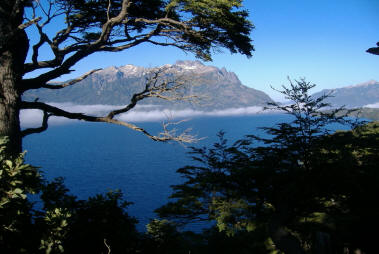
The Magellanic Islands Provide Some Of The World’s Most Amazing Sights – Getting There’s The Hard Part
By Madi Lang
Traveling to the Magellanic Islands is literally like traveling to the end of the world. Beginning from the Argentinean province of Tierra del Fuego and continuing to the east and the south, this area of the world offers up some of the most precious (and inaccessible) landscapes on the planet. Given the remoteness of the area, flights only go as far south to the city of Ushuaia (arguably the southernmost city in the world; Chile claims this title for the city of Puerto Williams which is technically further south, just arguably not a city). Thus, Ushuaia is a natural place to start a Southern Patagonian adventure.
When you fly in to Ushuaia keep your eyes peeled for the beautiful Martial Mountain Range (part of he Andes) before 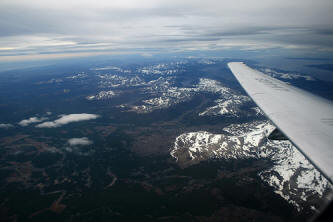 you descend through the billowing clouds that seem to always hang ominously over the city. I was surprised by the conflicting vistas I saw during my 15-minute taxi ride into town from the airport. The beautiful islands, mountains and waterways incongruously collide with a city that has been worn down by domestic immigration: only in the last 20 years has Ushuaia been a tourist hotspot and it is clear that the current inhabitants have done little to preserve the natural beauty of the land. Luckily, every inch of natural forest that is still intact is heavily protected and off limits to developers. Therefore, even though you’ll likely be sleeping within the city, it’s still easy to explore the incredible natural wonders that have escaped the footprint of man.
you descend through the billowing clouds that seem to always hang ominously over the city. I was surprised by the conflicting vistas I saw during my 15-minute taxi ride into town from the airport. The beautiful islands, mountains and waterways incongruously collide with a city that has been worn down by domestic immigration: only in the last 20 years has Ushuaia been a tourist hotspot and it is clear that the current inhabitants have done little to preserve the natural beauty of the land. Luckily, every inch of natural forest that is still intact is heavily protected and off limits to developers. Therefore, even though you’ll likely be sleeping within the city, it’s still easy to explore the incredible natural wonders that have escaped the footprint of man.
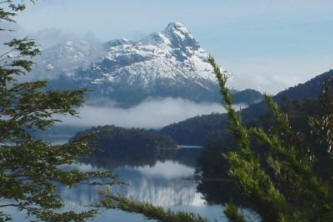 By starting your Magellanic expedition in Ushuaia, you can get a good grasp of the island’s unique flora and fauna by visiting the nearby Tierra del Fuego National Park. This is Argentina’s only national park with a coastline and while most of the preserve is restricted from visitors (for scientific purposes), you can still roam freely over a good portion of the land. One way to get there is by taking a 5-kilometer train ride run through raised sphagnum moss bogs and a sub-Antarctic forest via the Tren del Fin del Mundo (Train to the End of the World) — a train line built by Argentinean prisoners exiled to Ushuaia early last century.
By starting your Magellanic expedition in Ushuaia, you can get a good grasp of the island’s unique flora and fauna by visiting the nearby Tierra del Fuego National Park. This is Argentina’s only national park with a coastline and while most of the preserve is restricted from visitors (for scientific purposes), you can still roam freely over a good portion of the land. One way to get there is by taking a 5-kilometer train ride run through raised sphagnum moss bogs and a sub-Antarctic forest via the Tren del Fin del Mundo (Train to the End of the World) — a train line built by Argentinean prisoners exiled to Ushuaia early last century.
While exploring Ushuaia, you can take a daytrip to the famed ranch, Estancia Harberton. About 85 kilometers east of the city, the ranch is located on a narrow peninsula overlooking the Beagle Channel. The farm was founded in 1886, making it the oldest of its kind in Tierra del Fuego and the main farmhouse is the oldest house on the Argentinean part of the island. The founder of Estancia Haberton was a local pioneer and British missionary named Thomas Bridges, who was given the land by the government in thanks for his work 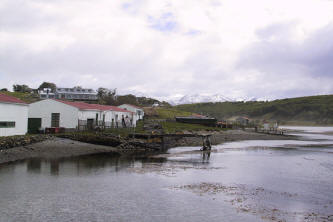 with the indigenous population. To reach the Estancia, you must go to the port of Ushuaia and take a boat tour. Once you arrive you can take a smaller boat to see a penguin colony and even spend some time walking amongst the little creatures.
with the indigenous population. To reach the Estancia, you must go to the port of Ushuaia and take a boat tour. Once you arrive you can take a smaller boat to see a penguin colony and even spend some time walking amongst the little creatures.
Once you’ve visited the largest of the Magellanic islands, it’s time to dole out some cash and hop on either the Via or Mare Australis ships and embark on the sailing trip of a lifetime. Each of these ships hold about 300 people and trips can last from 4 to 8 days. The cruise begins in either Punta Arenas (in Chile) or in Ushuaia and for those of us who shiver in disgust at the idea of a cruise, don’t let this hold you back. This is not your average luxury cruise: these vessels are concerned more about utility than comfort. Magellanic Patagonia will come into a completely different perspective when it’s seen from the upper deck of a small cruise ship. From here you can truly contemplate the deeper meanings of the words and phrases “remote” or “the middle of nowhere”.
From Ushuaia out towards the Atlantic Ocean there is no human life on land: no electricity, no outposts, and no campfires. The cruise ship is too large to enter into the numerous fjords interspersed along the coastline, so passengers must dawn lifejackets and hop into little Zodiac boats that take you to the islands and inlets that you’d never be able to see otherwise.
Depending on which trip you choose, you can explore several destinations including but not limited to: Magdalena Island (with 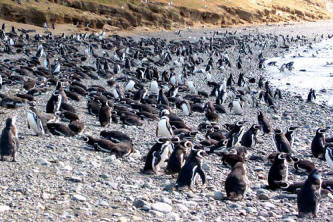 its population of over 120,000 penguins), Cape Horn (this trip is weather permitting given its notoriety as one of the world’s most inhospitable places to sail), and the Günter Plüschow Glacier where the deepest blues and whitest whites will shock your senses as you gaze out at your surroundings. One of the most popular stops is in Wulaia Bay, where the British Captain Fitz Roy (while on board the HMS Beagle) first encountered the Yámana aborigines in the 19th century.
its population of over 120,000 penguins), Cape Horn (this trip is weather permitting given its notoriety as one of the world’s most inhospitable places to sail), and the Günter Plüschow Glacier where the deepest blues and whitest whites will shock your senses as you gaze out at your surroundings. One of the most popular stops is in Wulaia Bay, where the British Captain Fitz Roy (while on board the HMS Beagle) first encountered the Yámana aborigines in the 19th century.
It’s impossible not to leave here without a true understanding of why the Magellanic Islands are such a naturally forbidden habitat. Upon visiting this region for the first time, Darwin recounted in his diary, “Whilst beholding these savages, one asks, whence have they come? What could have tempted, or what change compelled a tribe of men, to leave the fine regions of the north, to travel down the Cordillera or backbone of America, to invent and build canoes, which are not used by the tribes of Chile, Peru, and Brazil, and then to enter on one of the most inhospitable countries within the limits of the globe?” I think I can come up with a few reasons.

The post The Magellanic Islands: Traveling To The End Of The World appeared first on The Expeditioner Travel Site.
]]>